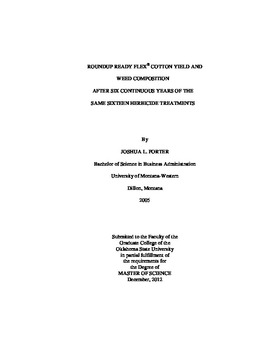| dc.contributor.advisor | Murray, Don | |
| dc.contributor.author | Porter, Joshua Lee | |
| dc.date.accessioned | 2014-04-15T22:06:18Z | |
| dc.date.available | 2014-04-15T22:06:18Z | |
| dc.date.issued | 2012-12-01 | |
| dc.identifier.uri | https://hdl.handle.net/11244/9357 | |
| dc.description.abstract | An experiment with Roundup Ready Flex� cotton was started in 2006 at the South Central Research Station near Chickasha, OK. The purpose of this research was to measure weed species composition and cotton yield in a continuous long-term experiment comparing glyphosate and conventional herbicide treatments. The experimental design was a randomized complete block design with 16 herbicide treatments replicated four times. Plot size was 12 rows (1.0 m per row spacing) X 30.5 m long. All weed counts and harvest data were collected from the four center rows of each plot. All herbicides used were applied at the labeled rates. The weeds that were most common in the experiment were johnsongrass, Palmer amaranth, and common cocklebur, and on drier years, silverleaf nightshade. Weed counts were taken after all treatments were applied. Cotton yield data were collected on all plots that were harvestable, except in 2011, no plots were harvested due to severe drought. Herbicides which were used in various combinations from 2006 through 2009 included trifluralin (PPI), prometryn (PRE), pyrithiobac (PRE and POST), glyphosate (POST), metolachlor (POST), and an untreated check. In 2010 and 2011, the entire experimental area was treated with a PPI application of trifluralin, and then a POST 1 application of glyphosate (various Monsanto formulations) on an as needed basis followed by a POST 2 and POST 3 application of glyphosate. Conventional herbicides applications from 2006 through 2009 did not control common cocklebur nor Palmer amaranth; therefore, those plots were not harvested. Data collected from 2006 through 2009 showed that eight of the 16 treatments were not harvested due to high populations of common cocklebur and Palmer amaranth. In 2010 the best management practices were trifluralin (PPI) followed by glyphosate (POST 2 and POST 3) and trifluralin (PPI) followed by glyphosate (POST 1, POST 2, and POST 3) provided effective weed control and all plots were harvested. The best management practices selected in 2010 successfully controlled the targeted weeds and allowed for a uniform cotton lint yield over the entire experiment area for the first time in experiment's history. Data from 2011 shows that cotton did not canopy over exposed soil in the row due to lack of water and abnormally hot and dry conditions; therefore there was noticeable increase in silverleaf nightshade in both of the treatments. | |
| dc.format | application/pdf | |
| dc.language | en_US | |
| dc.publisher | Oklahoma State University | |
| dc.rights | Copyright is held by the author who has granted the Oklahoma State University Library the non-exclusive right to share this material in its institutional repository. Contact Digital Library Services at lib-dls@okstate.edu or 405-744-9161 for the permission policy on the use, reproduction or distribution of this material. | |
| dc.title | Roundup Ready Flex Cotton Yield and Weed Composition After Six Continuous Years of the Same Sixteen Herbicide Treatments | |
| dc.type | text | |
| dc.contributor.committeeMember | Anderson, Kim Barry | |
| dc.contributor.committeeMember | Boman, Randy | |
| osu.filename | Porter_okstate_0664M_12366.pdf | |
| osu.college | Agricultural Sciences and Natural Resources | |
| osu.accesstype | Open Access | |
| dc.description.department | Department of Plant and Soil Sciences | |
| dc.type.genre | Thesis | |
| dc.subject.keywords | flex cotton | |
| dc.subject.keywords | glyphosate | |
| dc.subject.keywords | prometryn | |
| dc.subject.keywords | pyrithiobac | |
| dc.subject.keywords | quizalofop | |
| dc.subject.keywords | trifluralin | |
